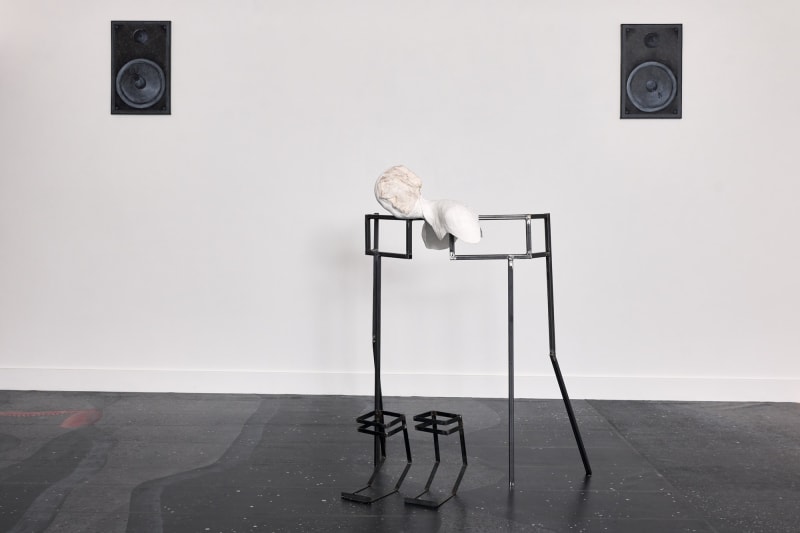On the occasion of London Gallery Weekend 2024, Fani Parali will present a series of performances on Saturday 1st June.
Performance times are: 11am, 12noon, 2pm, 3pm, 4pm and 5pm. Each performance lasts approximately 15 minutes.
All welcome.
In her ambitious new exhibition for Cooke Latham, Fani Parali invites viewers into an alternate realm, a space designed for and inhabited solely by children. Through this inversion of our own reality Parali, like all truly great purveyors of science fiction, not only looks ahead reflecting upon the challenges facing the next generation but also invites critical analysis of our societal status quo.
For 'Children of the Future' Parali has installed an intricately painted floor that covers the gallery like a second skin. Inspired by stellar constellations, neural pathways and industrial blueprints this becomes the unapologetically theatrical 'stage' upon which her sculptures and performers converse. An inky, 'star strewn', black it induces a feeling of cosmic vertigo for the viewer while also drawing them in with ambiguous, magnified, details. Optically destabilising the viewer is immediately forced to hold both the micro and the macro in the same glance.
Sculptures are scattered with purpose across the floor, their metal armatures pencil thin, as though the designs for future machines have taken on three-dimensional form. Each sculpture hosts a child, rendered in plaster cast. Fragile against the cold lines of the metal armatures these 'children' can be read both as unified with the 'machine' that holds them and as co-dependant but distinct.
The walls host a series of metal framed artworks. Two large paintings depict sleeping children in frames that ape the parameters of a cot. The viewer encounters them parentally, as though peering in on their sleeping progeny from above. The steel of the sculptures is duplicated in the frames that house these sleeping babes; their 'covers' a protective armature of metal.
Opposite these slumbering children, hung at the height of a five-year-old, are two smaller paintings, depicting "κρήνη" (Krini), public water fountains that in Greece are traditionally seen as portals to the afterlife. Another two paintings depicting music speakers are hung curiously high at one end of the gallery. The soundscape that permeates the exhibition is projected from the same wall giving a strange audio/ optical illusion that the paintings themselves are emitting the haunting recording.
Parali has crafted this new soundscape by channelling multiple voices, using recordings of both professional singers and children to create a call-and-response between the 'machine' of the gallery and the 'children' who inhabit it. A raw look into the increasingly symbiotic relationship between humans and machines, Children of the Future addresses the ramifications of unbridled technological progress on future generations. Though an implicit sense of terror permeates this union, the audio-work concurrently presents moments of harmony and uplift - a nod to the myriad possible futures that technology presents, and the possible redemption it could hold for our species.
Two performers lip-sync the haunting duet of a child with a machine; an adult performer opens their mouth, and the voice of a child emerges. The performers, like the sculptures are adorned with plaster casts that both support and confine their movements. Parali's work often focuses upon caregiving, with the fragile interconnectivity of care systems and our societal responsibility for one another. In 'Children of the Future' the metal armatures stand for both the endurance but also the limitations of the care systems we have collectively formulated.
Throughout the exhibition there is a sense of threshold spaces, of portals to alternate realities that sit, cheek-by-jowl, within the space of the gallery. The 'krini' are literal portals to the afterlife, the 'speakers' conduits for sound and thereby meaning. The giant sculpture that sits centrally in the gallery has the proportions of a door, within it a welded shape holds a tense vertical line, curiously like that of a tuning fork. Everywhere there is the sense of spaces beyond what we see, of energy and sound being channelled and the possible formulation of identity beyond the body's limited presence. In entering a space that is designed and occupied by children the viewer is invited to question whether children are, by virtue, more receptive to these threshold spaces than us. Whether in us, the 'adult', this child also lurks, willing to acknowledge alternate realities. Alternate futures.
Further performances will take over London Gallery Weekend on Saturday 1st June
Children of the Future, 2024 performance documentation by Mischa Haller
Duration: 16.30 mins
Performers: Vyvyan Stewardson (The Children and the Voice), PMBC (The Machine)
Voices: Valentine Nesbit, Thomas Nesbit, Leela Fiedler-Aswat (The Children), Elliot Lewis (The Machine), Amina Abbas Nazari (The Voice)

